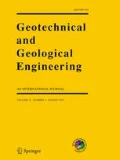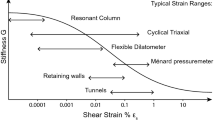Abstract
A backpropagation artificial neural network (ANN) model is developed to predict the secant friction angle of residual and fully softened soils, using data reported by Stark et al. (J Geotech Geoenviron Eng ASCE 131:575–588, 2005). In the ANN model, index properties such as liquid limit, plastic limit, activity, clay fraction and effective normal stress are used as input variables while secant residual friction angle is used as output variable. The model is verified using data that were not used for model training and testing. The results also indicate that the secant residual friction angle of cohesive soils can be predicted quite accurately using liquid limit, clay fraction and effective normal stress as input variables with R 2 = 0.93. The sensitivity analysis results indicate that plastic limit and activity have no appreciable effect on ANN predicted secant friction angles. The secant friction angle predictions of the ANN model were also compared with those of Stark’s et al. (2005) curves and the empirical formulas suggested for the same data sets by Wright (Evaluation of soil shear strengths for slope and retaining wall stability with emphasis on high plasticity clays, 2005). The comparison shows that the ANN model predictions are very close to those suggested by the Stark et al. (2005) curves but much better than the prediction of Wright’s (2005) empirical equations. The results also show that ANN is an alternative powerful tool to predict the secant friction angle of soils.











Similar content being viewed by others
References
Kenney TC (1967) Influence of mineralogical composition on the residual strength of natural soils. Proceedings of the Oslo Geotechnical Conference. Shear Strength Nat Soils Rocks Oslo 1:123–129
Lupini JF, Skinner AE, Vaughan PR (1981) The drained residual strength of cohesive soils. Geotechnique 31:181–213
Mesri G, Cepeda-Diaz AF (1986) Residual strength of clays and shales. Geotechnique 36:269–274
Skempton AW (1985) Residual strength of clays in landslides, folded strata and the laboratory. Geotechnique 35:3–18
Stark TD, Eid HT (1994) Drained residual strength of cohesive soils. J Geotech Eng 120:856–871. doi:10.1061/(ASCE)0733-9410(1994)120:5(856)
Stark TD, Choi H, McCone S (2005) Drained shear strength parameters for analysis of landslides. J Geotech Geoenviron Eng ASCE 131:575–588
Wright SG (2005) Evaluation of soil shear strengths for slope and retaining wall stability with emphasis on high plasticity clays, Research Report FHW/TX-06/51874-01-1. Center for Transportation Research, University of Texas at Austin, TX, 100 pp
Zurada JM (1992) Introduction to Artifical neural systems. West Publishing Company, New York
Author information
Authors and Affiliations
Corresponding author
Appendix A: Definition of Statistical Parameters
Appendix A: Definition of Statistical Parameters
The following error measuring parameters were used in evaluating the performance of the developed ANN model:
In the above equation, RMSE is Root Mean Square Error, RMSPE is Root Mean Square Percentage Error, and MAPE is Mean Absolute Percentage Error. The parameters in the error functions, x i is measured data, y i is ANN model prediction, n is number of data points, x is mean value of measured data, and y is the mean valued of ANN model prediction.
Rights and permissions
About this article
Cite this article
Kaya, A. Residual and Fully Softened Strength Evaluation of Soils using Artificial Neural Networks. Geotech Geol Eng 27, 281–288 (2009). https://doi.org/10.1007/s10706-008-9228-x
Received:
Accepted:
Published:
Issue Date:
DOI: https://doi.org/10.1007/s10706-008-9228-x




